Top of page
Australian Sentinel Practice Research Network
The Research and Health Promotion Unit of the Royal Australian College of General Practitioners operates the Australian Sentinel Practice Research Network (ASPREN). ASPREN is a national network of general practitioners who report presentations of defined medical conditions each week. The aim of ASPREN is to provide an indicator of the burden of disease in the primary health care setting and to detect trends in consultation rates.
There are currently about 50 general practitioners participating in the network from all states. Seventy-five per cent of these are in metropolitan areas and the remainder are rural based. Between 4,000 and 6,000 consultations are recorded each week.
The list of conditions is reviewed annually by the ASPREN management committee and an annual report is published.
In 2004, nine conditions are being monitored, five of which are related to communicable diseases. These include influenza, gastroenteritis, varicella and shingles. Definitions of these conditions are described in Surveillance systems reported in CDI, published in Commun Dis Intell 2004;28:99. Note that in 2004, two case definitions for influenza are being recorded in parallel.
Data from 1 July to 30 September 2004 are shown as the rate per 1,000 consultations in Figures 4, 5, 6 and 7.
Figure 4. Consultation rates for influenza-like illness, ASPREN, 1 July to 30 September 2004, by week of report
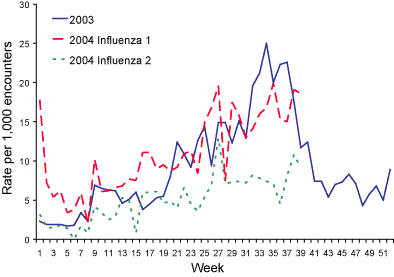
Figure 5. Consultation rates for gastroenteritis, ASPREN, 1 July to 30 September 2004, by week of report
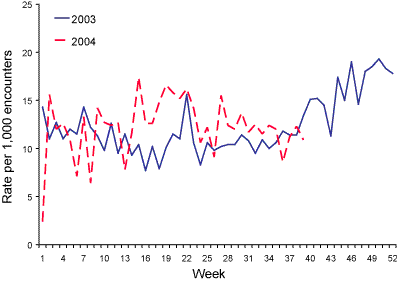
Figure 6. Consultation rates for chickenpox, ASPREN, 1 July to 30 September 2004, by week of report
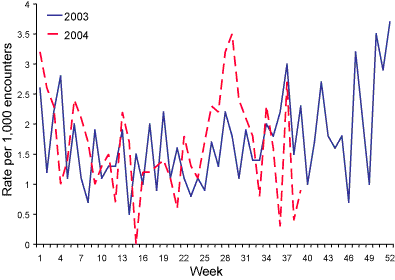
Top of page
Figure 7. Consultation rates for shingles, ASPREN, 1 July to 30 September 2004, by week of report
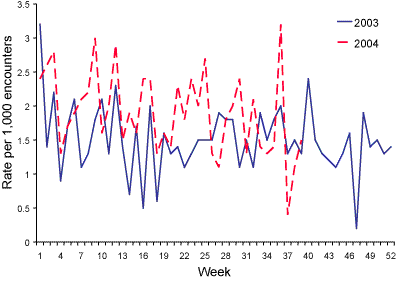
Childhood immunisation coverage
Tables 6, 7 and 8 provide the latest quarterly report on childhood immunisation coverage from the Australian Childhood Immunisation Register (ACIR).
The data show the percentage of children fully immunised at age 12 months for the cohort born between 1 April and 30 June 2003; at 24 months of age for the cohort born between 1 April and 30 June 2002; and at 6 years of age for the cohort born between 1 April and 30 June 1998, according to the Australian Standard Vaccination Schedule.
For information about the Australian Childhood Immunisation Register see Surveillance systems reported in CDI, published in Commun Dis Intell 2004;28:102 and for a full description of the methodology used by the Register see Commun Dis Intell 1998;22:36–37.
Commentary on the trends in ACIR data is provided by the National Centre for Immunisation Research and Surveillance of Vaccine Preventable Diseases (NCIRS). Telephone: +61 2 9845 1256. Email: brynleyh@chw.edu.au.
Immunisation coverage for 'fully immunised' at 12 months of age for Australia increased marginally from the last quarter by 0.4 percentage points to 91.3 per cent (Table 6). There was a substantial increase in 'fully immunised' coverage by State and Territory in one jurisdiction, the Northern Territory, with an increase of 5.3 percentage points, whilst all other jurisdictions experienced very little change in coverage. As expected, the Northern Territory also had increases in coverage for individual vaccines. Apparently large changes in coverage in jurisdictions like the Northern Territory and the Australian Capital Territory, who have relatively small populations, can result from small absolute numbers of unimmunised children and should be treated with caution.
Coverage for 'fully immunised' at 24 months of age for Australia increased marginally from the last quarter by 0.6 percentage points to 92.3 per cent (Table 7). Coverage for individual vaccines increased marginally in most jurisdictions with coverage greater than 95 per cent in almost all jurisdictions for all vaccines except Hib. HepB coverage at 24 months of age is now greater than 98 per cent in the Northern Territory.
Table 8 shows immunisation coverage estimates for 'fully immunised' and for individual vaccines at six years of age for Australia and by state/territory. 'Fully immunised' coverage at six years of age for Australia was unchanged overall, apart from increases in Tasmania (+3.1%) and in the Northern Territory (+4.1%), also reflected in individual vaccines. Coverage for vaccines assessed at six years is at or near 85 per cent in the most jurisdictions, but Western Australia remains well below the average.
Top of page
Figure 8 shows the trends in vaccination coverage from the first ACIR-derived published coverage estimates in 1997 to the current estimates. There is a clear trend of increasing vaccination coverage over time for children aged 12 months, 24 months and six years, although the rate of increase has slowed over the past year for all age groups. The figure shows that there have now been four consecutive quarters where 'fully immunised' coverage at 24 months of age has been greater than 'fully immunised' coverage at 12 months of age, following the removal of the requirement for 18 month DTPa vaccine.
Figure 8. Trends in vaccination coverage, Australia, 1997 to 2004, by age cohorts
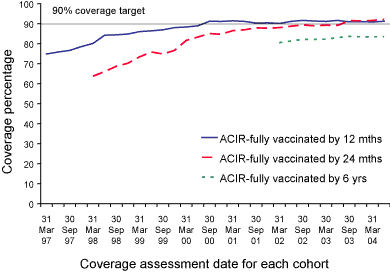
Table 6. Percentage of children immunised at 1 year of age, preliminary results by vaccine and state or territory for the birth cohort 1 April and 30 June 2003; assessment date 30 September 2004
| |
State or territory |
Australia |
| ACT |
NSW |
NT |
Qld |
SA |
Tas |
Vic |
WA |
| Number of children |
959 |
21,653 |
921 |
12,711 |
4,371 |
1,347 |
15,155 |
6,124 |
63,241 |
| Diphtheria, tetanus, pertussis (%) |
94.3 |
92.7 |
91.9 |
92.7 |
92.8 |
93.7 |
93.2 |
90.7 |
92.7 |
| Poliomyelitis (%) |
94.3 |
92.6 |
91.4 |
92.6 |
92.6 |
93.5 |
93.1 |
90.7 |
92.6 |
| Haemophilus influenzae type b (%) |
95.6 |
94.6 |
95.7 |
94.8 |
95.7 |
95.7 |
95.1 |
93.8 |
94.8 |
| Hepatitis B (%) |
95.3 |
95.3 |
96.3 |
94.8 |
95.8 |
95.6 |
94.7 |
93.3 |
94.9 |
| Fully immunised (%) |
93.4 |
91.3 |
90.5 |
91.7 |
91.7 |
92.4 |
91.7 |
88.8 |
91.3 |
| Change in fully immunised since last quarter (%) |
+2.7 |
+0.8 |
+5.3 |
+0.1 |
+0.3 |
-1.0 |
+0.0 |
-0.5 |
+0.4 |
Table 7. Percentage of children immunised at 2 years of age, preliminary results by vaccine and state or territory for the birth cohort 1 April and 30 June 2002, assessment date 30 September 2004*
| |
State or territory |
Australia |
|---|
| ACT |
NSW |
NT |
Qld |
SA |
Tas |
Vic |
WA |
| Number of children |
1,003 |
21,222 |
873 |
12,724 |
4,274 |
1,444 |
15,217 |
6,184 |
62,941 |
| Diphtheria, tetanus, pertussis (%) |
95.7 |
95.4 |
96.9 |
95.0 |
95.4 |
96.3 |
95.7 |
94.4 |
95.3 |
| Poliomyelitis (%) |
95.6 |
95.2 |
97.1 |
94.9 |
95.4 |
96.2 |
95.7 |
94.2 |
95.2 |
| Haemophilus influenzae type b (%) |
94.7 |
93.4 |
95.5 |
94.0 |
94.1 |
94.5 |
94.2 |
92.6 |
93.8 |
| Measles, mumps, rubella (%) |
95.0 |
93.5 |
95.5 |
93.9 |
94.5 |
94.7 |
94.6 |
92.8 |
93.9 |
| Hepatitis B(%) |
96.1 |
95.7 |
98.2 |
95.6 |
96.2 |
96.4 |
96.3 |
95.4 |
95.9 |
| Fully immunised (%) |
92.7 |
91.8 |
93.8 |
92.3 |
93.0 |
93.8 |
93.1 |
90.6 |
92.3 |
| Change in fully immunised since last quarter (%) |
+2.7 |
+0.8 |
-0.7 |
+0.4 |
+0.3 |
-1.0 |
+0.8 |
-0.0 |
+0.5 |
Top of page
Table 8. Percentage of children immunised at 6 years of age, preliminary results by vaccine and state or territory for the birth cohort 1 April and 30 June 1998; assessment date 30 September 2004
| |
State or territory |
Australia |
| ACT |
NSW |
NT |
Qld |
SA |
Tas |
Vic |
WA |
| Number of children |
1,049 |
21,810 |
892 |
13,394 |
4,674 |
1,496 |
15,498 |
6,733 |
65,546 |
| Diphtheria, tetanus, pertussis (%) |
85.9 |
85.3 |
83.7 |
85.1 |
85.3 |
85.2 |
87.4 |
81.6 |
85.4 |
| Poliomyelitis (%) |
86.0 |
85.2 |
85.3 |
85.2 |
85.4 |
85.2 |
86.9 |
82.0 |
85.3 |
| Measles, mumps, rubella (%) |
84.9 |
84.3 |
85.2 |
84.9 |
85.0 |
84.3 |
87.1 |
81.4 |
84.8 |
| Fully immunised (%) |
83.8 |
83.1 |
82.7 |
83.7 |
83.9 |
83.4 |
85.7 |
80.1 |
83.6 |
| Change in fully immunised since last quarter (%) |
-1.1 |
-0.0 |
+4.1 |
+0.0 |
+0.6 |
+3.1 |
+0.2 |
-1.0 |
+0.1 |
Acknowledgement:These figures were provided by the Health Insurance Commission (HIC), to specifications provided by the Australian Government Department of Health and Ageing. For further information on these figures or data on the Australian Childhood Immunisation Register please contact the Immunisation Section of the HIC: Telephone: +61 2 6124 6607.
Top of page
Gonococcal surveillance
John Tapsall, The Prince of Wales Hospital, Randwick, NSW, 2031 for the Australian Gonococcal Surveillance Programme
The Australian Gonococcal Surveillance Programme (AGSP) reference laboratories in the various States and Territories report data on sensitivity to an agreed 'core' group of antimicrobial agents quarterly. The antibiotics which are currently routinely surveyed are penicillin, ceftriaxone, ciprofloxacin and spectinomycin, all of which are administered as single dose regimens and currently used in Australia to treat gonorrhoea. When in vitro resistance to a recommended agent is demonstrated in 5% or more of isolates from a general population, it is usual to remove that agent from the list of recommended treatments.1 Additional data are also provided on other antibiotics from time to time. At present all laboratories also test isolates for the presence of high level (plasmid-mediated) resistance to the tetracyclines, known as TRNG. Tetracyclines are however not a recommended therapy for gonorrhoea in Australia. Comparability of data is achieved by means of a standardised system of testing and a programme-specific quality assurance process. Because of the substantial geographic differences in susceptibility patterns in Australia, regional as well as aggregated data are presented.
Reporting period 1 July to 30 September 2004
The AGSP laboratories examined a total of 829 isolates in this quarter. The total is slightly less than the 857 isolated or referred in 2003. About 31% of the current total was from New South Wales, 24% from Victoria, 19% from Queensland, 13% from the Northern Territory, 10% from Western Australia and 3% from South Australia. Isolates from Tasmania (6) and the Australian Capital Territory (4) were few.
Top of page
Quinolone antibiotics
The total number (200) and proportion (24%) of all quinolone resistant N. gonorrhoeae (QRNG) is at an historical high. In the first quarter of 2004 there were 188 QRNG (20.5%), and in the second quarter 172 (20.2%). The numbers here are substantially higher than the corresponding figures in the third quarter of 2003 (136 isolates, 16%). The majority of the QRNG (184 of 200, 92%) exhibited higher-level resistance. QRNG are defined as those isolates with an MIC to ciprofloxacin equal to or greater than 0.06mg/L. QRNG are further subdivided into less sensitive (ciprofloxacin MICs 0.06–0.5 mg/L) or resistant (MIC ≥1 mg/L) groups.
QRNG were again widely distributed. The highest number, 93, was found in New South Wales (36.6% of isolates in that State) while 64 QRNG were 33% of gonococci in Victoria. In Queensland there were 27 QRNG (17%), seven in Western Australia (9%), four in South Australia (17%), two in both the Northern Territory and Tasmania and one in the Australian Capital Territory.
Figure 9. The distribution of quinolone resistant isolates of Neisseria gonorrhoeae in Australia by jurisdiction, 1 July to 30 September 2004
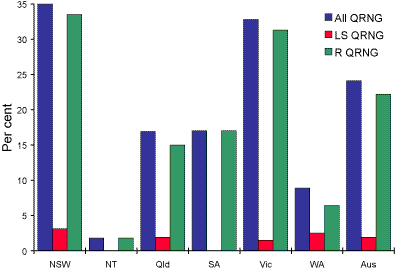
Penicillins
In this quarter 20% of all isolates examined were penicillin resistant by one or more mechanisms—10.6% penicillinase producing N. gonorrhoeae (PPNG) and 9.4% by chromosomal mechanisms (CMRNG). The proportion of all penicillin resistant strains is little changed from the previous quarter and a slight increase from the 18% detected in the third quarter of 2003. The number of PPNG increased to 88 from the 77 seen in the same period in 2003, but the number of CMRNG was essentially unchanged (77 for this period in 2004, 76 in 2003). The proportion of all strains resistant to the penicillins by any mechanism ranged from 3.8% in the Northern Territory to 33% in Western Australia.
Figure 10 shows the proportions of gonococci fully sensitive (MIC ≤ 0.03 mg/L), less sensitive (MIC 0.06 – 0.5 mg/L), relatively resistant (MIC ≥1 mg/L) or else PPNG, aggregated for Australia and by State and Territory. A high proportion those strains classified as PPNG or else resistant by chromosomal mechanisms fail to respond to treatment with penicillins (penicillin, amoxycillin, ampicillin) and early generation cephalosporins.
Figure 10. Categorisation of gonococci isolated in Australia by penicillin susceptibility and by region, 1 July to 30 September 2004
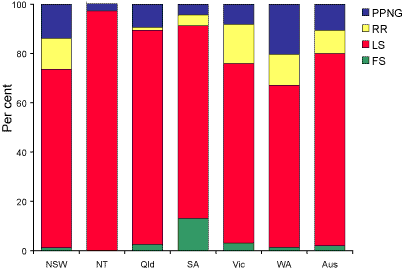
Top of page
The highest proportion of PPNG was found in Western Australia where the 16 PPNG were 20.3% of all isolates. Thirty-five PPNG representing 13.8% of all isolates were found in New South Wales, 15 (9.4%) in Queensland and 16(8.2%) in Victoria. There was a single PPNG in South Australia, Tasmania and the Australian Capital Teritory and three in the Northern Territory. The number of CMRNG was highest in Victoria (31, 16%) and New South Wales (32, 13%) and in Western Australia 10 CMRNG isolates were 12.6% of the total. Elsewhere CMRNG were in low numbers (Queensland, Tasmania, South Australia) or absent (Northern Territory, Australian Capital Territory).
Ceftriaxone
An increased number of isolates (12, 4.7%) with decreased susceptibility to ceftriaxone were detected in New South Wales in this quarter, but none were seen elsewhere. Small numbers of these strains have been present for a number of years, mostly in New South Wales, but only occasionally in other jurisdictions.
Spectinomycin
All isolates susceptible to this injectable agent.
High level tetracycline resistance (TRNG)
Both the number (121) and proportion (14.6%) of TRNG continued to increase from the 2003 figures (92, 11.5%). TRNG were found in all jurisdictions with 22 (28%) in Western Australia, 56 (22%) in New South Wales, 18 (11%) in Queensland and 19 (10%) in Victoria.
Reference
1. Anonymous. Management of sexually transmitted diseases. World Health Organization 1997; Document WHO/GPA/TEM94.1 Rev.1 p 37.
Top of page
Meningococcal surveillance
John Tapsall, The Prince of Wales Hospital, Randwick, NSW, 2031 for the Australian Meningococcal Surveillance Programme.
The reference laboratories of the Australian Meningococcal Surveillance Programme report data on the number of laboratory confirmed cases confirmed either by culture or by non-culture based techniques. Culture positive cases, where a Neisseria meningitidis is grown from a normally sterile site or skin, and non-culture based diagnoses, derived from results of nucleic acid amplification assays and serological techniques, are defined as invasive meningococcal disease (IMD) according to Public Health Laboratory Network definitions. Data contained in the quarterly reports are restricted to a description of the number of cases per jurisdiction, and serogroup, where known. A full analysis of laboratory confirmed cases of IMD is contained in the annual reports of the Programme, published in Communicable Diseases Intelligence.
Laboratory confirmed cases of invasive meningococcal disease for the period 1 July to 30 September 2004, are included in this issue of Communicable Diseases Intelligence (Table 9).
Top of page
Table 9. Number of laboratory confirmed cases of invasive meningococcal disease, Australia, 1 July to 30 September 2004, by jurisdiction and serogroup
| Jurisdiction |
Year |
Serogroup |
| A |
B |
C |
Y |
W135 |
ND |
All |
| Q3 |
ytd |
Q3 |
ytd |
Q3 |
ytd |
Q3 |
ytd |
Q3 |
ytd |
Q3 |
ytd |
Q3 |
ytd |
| Aust Capital Territory |
2004 |
|
|
0 |
3 |
3 |
7 |
|
|
|
|
|
|
3 |
10 |
| 2003 |
|
|
(2) |
(3) |
(2) |
(2) |
|
|
|
|
|
|
(4) |
(5) |
| New South Wales |
2004 |
|
|
22 |
60 |
6 |
15 |
1 |
3 |
2 |
4 |
2 |
12 |
33 |
94 |
| 2003 |
|
|
(38) |
(75) |
(19) |
(32) |
(1) |
(4) |
(0) |
(1) |
(3) |
(15) |
(61) |
(127) |
| Northern Territory |
2004 |
|
|
0 |
5 |
0 |
0 |
|
|
0 |
1 |
|
|
0 |
6 |
| 2003 |
|
|
(3) |
(9) |
(0) |
(0) |
|
|
(1) |
(1) |
|
|
(4) |
(10) |
| Queensland |
2004 |
0 |
1 |
13 |
36 |
8 |
20 |
0 |
1 |
1 |
2 |
0 |
2 |
22 |
62 |
| 2003 |
(1) |
(1) |
(17) |
(34) |
(16) |
(31) |
(1) |
(1) |
(0) |
(0) |
(0) |
(8) |
(35) |
(75) |
| South Australia |
2004 |
|
|
2 |
11 |
1 |
1 |
|
|
|
|
|
|
3 |
12 |
| 2003 |
|
|
(7) |
(15) |
(1) |
(2) |
(1) |
(1) |
(1) |
(1) |
|
|
(10) |
(19) |
| Tasmania |
2004 |
|
|
3 |
6 |
5 |
5 |
|
|
0 |
1 |
1 |
3 |
9 |
15 |
| 2003 |
|
|
(3) |
(3) |
(4) |
(5) |
|
|
|
|
|
|
(7) |
(8) |
| Victoria |
2004 |
|
|
17 |
45 |
3 |
12 |
0 |
3 |
2 |
2 |
1 |
3 |
23 |
65 |
| 2003 |
|
|
(22) |
(35) |
(17) |
(39) |
(2) |
(2) |
(0) |
(1) |
(1) |
(6) |
(42) |
(83) |
| Western Australia |
2004 |
|
|
11 |
23 |
2 |
4 |
|
|
1 |
1 |
|
|
14 |
28 |
| 2003 |
|
|
(11) |
(22) |
(2) |
(5) |
(0) |
(1) |
|
|
|
|
(13) |
(28) |
| Australia |
2004 |
0 |
1 |
68 |
189 |
28 |
64 |
1 |
7 |
6 |
11 |
4 |
20 |
107 |
292 |
| 2003 |
(1) |
(1) |
(103) |
(196) |
(61) |
(116) |
(5) |
(9) |
(2) |
(4) |
(4) |
(29) |
(176) |
(355) |
Top of page
HIV and AIDS surveillance
National surveillance for HIV disease is coordinated by the National Centre in HIV Epidemiology and Clinical Research (NCHECR), in collaboration with State and Territory health authorities and the Commonwealth of Australia. Cases of HIV infection are notified to the National HIV Database on the first occasion of diagnosis in Australia, by either the diagnosing laboratory (Australian Capital Territory, New South Wales, Tasmania, Victoria) or by a combination of laboratory and doctor sources (Northern Territory, Queensland, South Australia, Western Australia). Cases of AIDS are notified through the State and Territory health authorities to the National AIDS Registry. Diagnoses of both HIV infection and AIDS are notified with the persons date of birth and name code, to minimise duplicate notifications while maintaining confidentiality.
Tabulations of diagnoses of HIV infection and AIDS are based on data available three months after the end of the reporting interval indicated, to allow for reporting delay and to incorporate newly available information. More detailed information on diagnoses of HIV infection and AIDS is published in the quarterly Australian HIV Surveillance Report, and annually in HIV/AIDS, viral hepatitis and sexually transmissible infections in Australia, annual surveillance report. The reports are available from the National Centre in HIV Epidemiology and Clinical Research, 376 Victoria Street, Darlinghurst NSW 2010. Internet:
http://www.med.unsw.edu.au/nchecr. Telephone: +61 2 9332 4648. Facsimile: +61 2 9332 1837. For more information see Surveillance systems reported in CDI, published in Commun Dis Intell 2004;28:99.
HIV and AIDS diagnoses and deaths following AIDS reported for 1 April to 30 June 2004, as reported to 30 September 2004, are included in this issue of Communicable Diseases Intelligence (Tables 10 and 11).
Top of page
Table 10. New diagnoses of HIV infection, new diagnoses of AIDS and deaths following AIDS occurring in the period 1 April to 30 June 2004, by sex and state or territory of diagnosis
| |
Sex |
State or Territory |
| ACT |
NSW |
NT |
Qld |
SA |
Tas |
Vic |
WA |
This period 2004 |
This period 2003 |
Year to date 2004 |
Year to date 2003 |
| HIV diagnoses |
Female |
0 |
10 |
0 |
7 |
1 |
1 |
10 |
0 |
29 |
23 |
67 |
43 |
| Male |
0 |
82 |
0 |
28 |
4 |
3 |
41 |
0 |
158 |
208 |
359 |
410 |
| Not reported |
0 |
1 |
0 |
0 |
0 |
0 |
0 |
0 |
1 |
1 |
2 |
2 |
| Total1 |
0 |
93 |
0 |
35 |
5 |
4 |
51 |
0 |
188 |
232 |
429 |
455 |
| AIDS diagnoses |
Female |
0 |
2 |
0 |
1 |
0 |
0 |
1 |
0 |
4 |
3 |
7 |
7 |
| Male |
0 |
11 |
0 |
7 |
2 |
1 |
3 |
0 |
24 |
52 |
62 |
87 |
| Total1 |
0 |
13 |
0 |
8 |
2 |
1 |
4 |
0 |
28 |
55 |
70 |
95 |
| AIDS deaths |
Female |
0 |
1 |
0 |
0 |
0 |
0 |
0 |
0 |
1 |
1 |
2 |
5 |
| Male |
0 |
7 |
0 |
3 |
5 |
0 |
0 |
0 |
15 |
14 |
27 |
31 |
| Total1 |
0 |
8 |
0 |
3 |
5 |
0 |
0 |
0 |
16 |
15 |
29 |
36 |
Table 11. Cumulative diagnoses of HIV infection, AIDS and deaths following AIDS since the introduction of HIV antibody testing to 30 June 2004, by sex and state or territory
| |
Sex |
State or Territory |
| ACT |
NSW |
NT |
Qld |
SA |
Tas |
Vic |
WA |
Australia |
| HIV diagnoses |
Female |
30 |
759 |
17 |
222 |
82 |
8 |
303 |
159 |
1,580 |
| Male |
247 |
12,507 |
121 |
2,373 |
805 |
88 |
4,664 |
1,049 |
21,854 |
| Not reported |
0 |
238 |
0 |
0 |
0 |
0 |
22 |
0 |
260 |
| Total1 |
277 |
13,532 |
138 |
2604 |
888 |
96 |
5,008 |
1,215 |
23,758 |
| AIDS diagnoses |
Female |
9 |
220 |
1 |
61 |
30 |
4 |
91 |
34 |
450 |
| Male |
92 |
5,094 |
41 |
964 |
385 |
48 |
1,844 |
407 |
8,875 |
| Total1 |
101 |
5,329 |
42 |
1,027 |
416 |
52 |
1,945 |
443 |
9,355 |
| AIDS deaths |
Female |
6 |
127 |
0 |
40 |
20 |
2 |
58 |
22 |
275 |
| Male |
71 |
3,442 |
26 |
625 |
262 |
32 |
1,353 |
277 |
6,088 |
| Total1 |
77 |
3,578 |
26 |
667 |
282 |
34 |
1,419 |
300 |
6,383 |
Top of page
National Enteric Pathogens Surveillance System
The National Enteric Pathogens Surveillance System (NEPSS) collects, analyses and disseminates data on human enteric bacterial infections diagnosed in Australia. These pathogens include Salmonella, E. coli, Vibrio, Yersinia, Plesiomonas, Aeromonas and Campylobacter. Communicable Diseases Intelligence quarterly reports include only Salmonella.
Data are based on reports to NEPSS from Australian laboratories of laboratory-confirmed human infection with Salmonella. Salmonella are identified to the level of serovar and, if applicable, phage-type. Infections apparently acquired overseas are included. Multiple isolations of a single Salmonella serovar/phage-type from one or more body sites during the same episode of illness are counted once only. The date of the case is the date the primary diagnostic laboratory isolated a Salmonella from the clinical sample.
Note that the historical quarterly mean counts should be interpreted with caution, and are affected by surveillance artefacts such as newly recognised (such as S. Typhimurium 197 and S. Typhimurium U290) and incompletely typed Salmonella.
Reported by Joan Powling (NEPSS Co-ordinator) and Mark Veitch (Public Health Physician), Microbiological Diagnostic Unit—Public Health Laboratory, Department of Microbiology and Immunology, University of Melbourne. NEPSS can be contacted at the above address or by telephone: +61 3 8344 5701, or facsimile: +61 3 9625 2689.
Reports to the National Enteric Pathogens Surveillance System of Salmonella infection for the period 1 July to 30 September 2004 are included in Tables 12 and 13. Data include cases reported and entered by 28 October 2004. Counts are preliminary, and subject to adjustment after completion of typing and reporting of further cases to NEPSS. For more information about NEPSS see Surveillance systems reported in CDI, published in Commun Dis Intell 2004;28:101.
Top of page
1 July to 30 September 2004
The total number of reports to NEPSS of human Salmonella infection declined to 1,156 in the third quarter of 2004, 42 per cent fewer than in second quarter of 2004 (Table 1) but 19 per cent more than the final count for the third
quarter of 2004. Case counts to 28 October 2004 are expected to comprise more than 95 per cent of the final counts for the quarter.
During the third quarter of 2004, the 25 most common Salmonella types in Australia accounted for 669 cases, 58 per cent of all reported human Salmonella infections (Table 2).
Eighteen of the 25 most common Salmonella infections in the third quarter of 2004 were among the 25 most commonly reported in the previous quarter.
Reports of common salmonellae with counts well above historical averages include S. Typhimurium phage type 197 (in the eastern mainland states), S. Virchow phage type 8 (particularly in Queensland and New South Wales), and S. Stanley (particularly in Victoria). Counts of several typically overseas-acquired phage types of S. Enteritidis were also elevated. While still among the more common salmonellae, reports of S. Typhimurium phage type 170/108 declined in number and relative prominence.
We thank scientists, diagnostic and reference laboratories, State and Territory health departments, and the Australian Government Department of Health and Ageing for their contributions to NEPSS.
Acknowledgement: Thanks to contributing laboratories and scientists.
Table 12. Reports to the National Enteric Pathogens Surveillance System of Salmonella isolated from humans during the period 1 July to 30 September 2004, as reported to 28 October 2004
| |
ACT |
NSW |
NT |
Qld |
SA |
Tas |
Vic |
WA |
Australia |
| Total all Salmonella for quarter |
17 |
263 |
68 |
355 |
69 |
11 |
238 |
135 |
1,156 |
| Total contributing Salmonella types |
12 |
91 |
29 |
102 |
33 |
10 |
88 |
65 |
209 |
Top of page
Table 13. Top 25 Salmonella types identified in Australia, by state or territories, 1 July to 30 September 2004
| National rank |
Salmonella type |
State or Territory |
Total 3rd quarter 2004 |
Last 10 years mean 3rd quarter |
Year to date 2004 |
Year to date 2003 |
| ACT |
NSW |
NT |
Qld |
SA |
Tas |
Vic |
WA |
| 1 |
S. Typhimurium 135 |
0 |
20 |
0 |
31 |
4 |
0 |
20 |
26 |
101 |
77 |
450 |
559 |
| 2 |
S. Typhimurium 197 |
2 |
8 |
0 |
39 |
0 |
0 |
14 |
0 |
63 |
5 |
203 |
134 |
| 3 |
S. Saintpaul |
0 |
8 |
7 |
24 |
1 |
0 |
5 |
9 |
54 |
41 |
290 |
230 |
| 4 |
S. Typhimurium 9 |
1 |
5 |
0 |
4 |
9 |
1 |
18 |
2 |
40 |
74 |
287 |
338 |
| 5 |
S. Virchow 8 |
2 |
12 |
0 |
22 |
1 |
0 |
2 |
0 |
39 |
18 |
269 |
130 |
| 6 |
S. Typhimurium 170 |
4 |
13 |
0 |
7 |
0 |
1 |
10 |
0 |
35 |
19 |
413 |
340 |
| 7 |
S. Birkenhead |
0 |
8 |
1 |
18 |
0 |
0 |
0 |
0 |
27 |
20 |
198 |
140 |
| 8 |
S. Chester |
0 |
7 |
4 |
8 |
5 |
0 |
0 |
3 |
27 |
20 |
156 |
174 |
| 9 |
S. Stanley |
1 |
4 |
1 |
4 |
1 |
0 |
11 |
4 |
26 |
13 |
59 |
35 |
| 10 |
S. Enteritidis 6a |
0 |
3 |
0 |
3 |
1 |
1 |
8 |
10 |
26 |
3.2 |
50 |
15 |
| 11 |
S. Typhimurium RDNC |
0 |
13 |
0 |
3 |
3 |
0 |
5 |
0 |
24 |
15 |
84 |
54 |
| 12 |
S. Infantis |
0 |
5 |
2 |
1 |
1 |
0 |
10 |
3 |
22 |
21 |
113 |
165 |
| 13 |
S. Aberdeen |
0 |
2 |
1 |
13 |
0 |
1 |
2 |
0 |
19 |
11 |
91 |
67 |
| 14 |
S. Weltevreden |
0 |
3 |
2 |
8 |
0 |
0 |
5 |
1 |
19 |
7 |
59 |
34 |
| 15 |
S.Muenchen |
0 |
4 |
2 |
5 |
2 |
0 |
1 |
4 |
18 |
16 |
90 |
109 |
| 16 |
S. Enteritidis 4b |
0 |
1 |
0 |
0 |
0 |
1 |
14 |
2 |
18 |
4.4 |
29 |
11 |
| 17 |
S. Typhimurium 126 |
0 |
5 |
0 |
1 |
1 |
0 |
6 |
1 |
14 |
19 |
58 |
55 |
| 18 |
S. Ball |
0 |
0 |
14 |
0 |
0 |
0 |
0 |
0 |
14 |
6 |
49 |
39 |
| 19 |
S. Typhimurium 12 |
0 |
9 |
0 |
1 |
0 |
0 |
3 |
0 |
13 |
4.3 |
202 |
74 |
| 20 |
S. Litchfield |
0 |
5 |
4 |
4 |
0 |
0 |
0 |
0 |
13 |
3.6 |
34 |
30 |
| 21 |
S. Enteritidis 1 |
0 |
3 |
0 |
2 |
3 |
0 |
3 |
1 |
12 |
6 |
32 |
12 |
| 22 |
S. Enteritidis 1b |
0 |
6 |
0 |
1 |
0 |
0 |
2 |
3 |
12 |
1.2 |
26 |
10 |
| 23 |
S. Agona |
1 |
1 |
1 |
4 |
1 |
0 |
1 |
2 |
11 |
13 |
63 |
53 |
| 24 |
S. Typhimurium untypable |
0 |
4 |
0 |
2 |
0 |
0 |
4 |
1 |
11 |
11 |
22 |
18 |
| 25 |
S. Hvittingfoss |
0 |
2 |
0 |
7 |
1 |
0 |
1 |
0 |
11 |
9 |
117 |
73 |
These reports were published in Communicable Diseases Intelligence Vol 28 No 4, December 2004.
